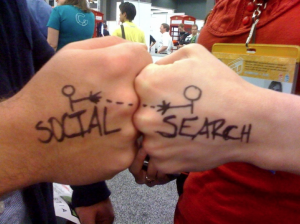Virality is one of those words that means something new on the internet. It’s become a short word for ‘lots of social media traffic’, but virality isn’t the same thing as popularity – the latter implies a one-to-many channel, many people clicking on a single shared link, where the former is many-to-many, more about the network than the individual, and more about the volume of subsequent shares than the initial link drop. What makes it happen? Here’s a partial list.
Identity
What people share isn’t the same as what they consume. (Any survey of the book titles on show at a Shoreditch coffee shop should demonstrate that beautifully.) People consume things they’re interested in; people share things that they think make them look good to the people they share them with. Identity is external and socially constructed, and the internet makes that astonishingly clear; we are, online, idealised and caricatured versions of our selves, the best selves we can be to the people whose opinions we care about in those social spaces. So we share not what we read, but what we believe others will think better of us for both reading and passing on. (This is why frictionless sharing gets such a massive backlash.)
The right thing for the right platform
Virality is something that varies with context. The biggest viral hit I’ve ever had on this blog was a post written the day after the Olympic opening ceremony – that got a lot of Twitter traffic for a day, because that’s where the conversation was, and then it all disappeared. Grant, on the other hand, wrote a roleplaying tips article that picked up steam through Facebook and a wide range of forums, then through Stumbleupon; as well as three separate peaks of interest, it has a very, very long tail of traffic that still reaches it more than a month after publication.
Guardian articles go viral at different levels, in different communities, in different ways, every day. Different platforms have different effects, because of the relative stickiness and longevity of content posted there. The half-life of a Twitter spike is very short, often less than a day; Facebook’s are longer; Stumbleupon’s have lower peaks but are longer still. The half-life of an article, image or video is very much related to the platforms it works for.
Embrace a niche
A little-explored element of viral traffic is all those other websites that send tiny portions of intensely interested traffic. Forums devoted to niche topics might only send ten or twenty visits, but if those visitors like what they see they are likely, these days, to also have networks in other places that will share their hobbies. For example, most people on an RPG forum are friends on Facebook or Twitter with a few folks interested in RPGs; if they see something good, they’re likely to want to pass it on.
Honesty
One of the reasons Buzzfeed works is that its headlines are absolutely clear and honest about what you’re going to get. @expresident at Storyology yesterday talked about the fact that even the number in a list headline gives the reader clues – 53 Cats That Don’t Like You is telling you not just what you’ll find but also how long it’ll take you to get through it, and whether it’ll matter if you have to get off a train / go back to work in the mean time. I can share that headline without feeling like it’s incomplete, like it tricks anyone whose opinion I might care about. And I can click on it knowing what I’m getting myself into. The Mail Online is also excellent at this, though less good at making headlines of sanely tweetable length.
Flirtatiousness
There’s another school of thought here, which I’ll call the Upworthy Teaser approach to headlines, where the idea is to create a social post that demands a click to find out what on earth is going on. This Amazingly Heartwarming Video Will Restore Your Faith In Humanity – often it does, and often it’s shareable. But there’s also a backlash against this kind of head – @huffpospoilers is a case in point – and there’s a certain friction here for some people in passing it on unedited. It’s very, very clickable, but it requires a certain type of content to make it work – to make certain people don’t feel tricked when they click. If you’re telling me I’m going to feel something and I don’t, that’s a dangerous play. It’s one step up from One Weird Trick.
Easiness
You know those websites that don’t have social buttons, or that don’t let you paste a quote without pasting a whole bunch of copyright stuff and extra code around it? Don’t do that. Don’t annoy people who want to share your things. This should be obvious, but it’s too often overlooked. Remove as many barriers as possible.
Emotion
An emotional response is generally something we want to share with other people we think are going to feel the same way. If something makes you feel sad, or happy, or furious, or like you’re going to literally cry from how amazingly cute it is, that’s something you’re likely to want to share with other people. This ties in with identity, too – sharing that feeling is a way of bonding with people, of saying: here are feelings I have, do you have them too? It’s a way of making friends. Through cat gifs. Isn’t the internet brilliant?
Quality
Make it good. There are no cheap tricks here. The things that go truly massive are truly good: truly funny, truly interesting, truly deep. Good reporting is only one dimension of quality here – hilarious things, morbidly fascinating things, distressing but important things all go viral because of their nature. But you can’t fake funny with a cute headline, and if it isn’t the best thing it can be it probably won’t take off.
Controversy
The one exception to the above is, of course, things that make people angry, which can be absolutely horrendous and get a lot of traffic. Outrage is a powerful motivator. But it’s also not generally something that drives a lot of positive association, so if you’re after loyal audience it’s probably best – in the long run – to go for the “OMG this is terrible, don’t you agree” approach rather than just publishing awful things. Some things straddle the line, and go viral in part because people argue about them; those pieces tread a dangerous but interesting path, in which they need to be both defensible and defended by people whose opinions are reflected in the piece in order to be sustainable.
Necessary but not sufficient
All of these elements are worth considering, if you’re trying to make something take off. I’d put identity, honesty and quality as the top three, but other people make different things that work in different ways and play off others. But none is sufficient in and of itself to make something catch on widely. Timing is crucial but often unknowable; sometimes things work because they coincide with a broad trend, while other things fall flat because they coincide with too many other things being published around the same broad trend. Excellent things fall down, despite everything being done right; good things do well despite several things not working as well as they could. Networks are inherently unpredictable, and often fickle. For sustained traffic, it helps to have both a network approach and a broadcast approach, that feed off each other and support each other. And to remember that people are just people, even in aggregate on the other end of an anonymous internet, and what people like isn’t all that hard to predict, if you’re honest with yourself.
This post was partly written in response to folks on Help Me Write, where I’m kinda testing the water at the moment. If you want to help me keep to my vague promise of more regular bloggery, head there and vote for stuff you want to read, or suggest ideas.



